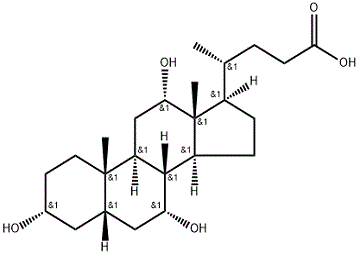English Synonyms
3,7,12-Trihydroxy-cholan-24-oicacid;5beta-Cholan-24-oicacid,3alpha,7alpha,12alpha-trihydroxy-;Cholan-24-oicacid,3,7,12-trihydroxy-,(3alpha,5beta,7alpha,12alpha)-;3,7,12-TRIHYDROXYCHOLANICACID;3A,7A,12A-TRIHYDROXY-5B-CHOLAN-24-OICACID;3ALPHA,7ALPHA,12ALPHA-TRIHYDROXY-5BETA-CHOLANICACID;3ALPHA,7ALPHA,12ALPHA-TRIHYDROXY-5BETA-CHOLAN-24-ICACID;3ALPHA,7ALPHA,12ALPHA-TRIHYDROXY-5BETA-CHOLAN-24-OICACID
Cholic Acid Properties
| Melting Point | 200-201 °C (lit.) |
| Specific Rotation | 36 º (c=0.6, 95% EtOH) |
| Boiling Point | 449.08°C (rough estimate) |
| Density | 1.0310 (rough estimate) |
| Refractive Index | 1.5800 (estimate) |
| Flash Point | 9℃ |
| Storage Condition | 2-8°C |
| Form | Solid |
| Acidity Coefficient (pKa) | 4.98(at 20℃) |
| Water Solubility | 0.28 g/L (15 ºC) |
Uses and Synthesis of Cholic Acid
Introduction
Bile Acid Is a Host-Microbiome Related Metabolite, Which Is a Colorless Flake or White Crystalline Powder That Can Regulate Host Immunity and Microbial Virulence. Bile Acid Is Synthesized in the Host and Secreted into the Intestine, And Microorganisms Can Further Metabolize It into Primary and Secondary Bile Acids with Diverse Structures. They Have Been Found to Play a Role in Host Immune Regulation and Antibacterial Effects.
Identification Test
Solubility: Very Difficult to Dissolve in Water; Soluble in Ethanol. Determined by Ot-42 Method. Melting Range 197~202℃. Determined by Conventional Method. Prepare 0.02% Sample Solution with 50% Acetic Acid Solution, Take 1ml, Add 1% Furfural Solution 1ml, Water 6ml and Concentrated Sulfuric Acid 5ml. The Mixed Solution Should Turn into Rose Color and Then Purple Within 5min. Take About 10mg of the Sample, Add 2 Drops of Benzaldehyde and 3 Drops of 3:1 Sulfuric Acid, And Heat at 50℃ for 5min. Add About 10ml of Glacial Acetic Acid, It Should Turn Brown.
Content Analysis
Accurately Weigh About 400 Mg of the Sample After Vacuum Drying at 140℃ for 4 Hours, Put It into a 250ml Flask, Add 20ml of Water and 40ml of Ethanol, Cover with a Watch Glass, Gently Heat on a Steam Bath Until Dissolved, And Then Cool. Add 5 Drops of Phenolphthalein Test Solution (Ts-167), Titrate with 0.1mol/L Sodium Hydroxide Solution Until Pink and Keep for 15s. At the Same Time, Perform a Blank Test and Make Necessary Corrections. Each Ml of 0.1mol/L Sodium Hydroxide Is Equivalent to 40.86mg of Bile Acid (C24 H40o5).
Toxicity
ADI O~1.25mg/kg(FAO/WH0,2001).
Chemical Properties
This Product Exists in the Bile of Cattle, Sheep and Pigs. It Is a Colorless Flake or White Crystalline Powder. It Tastes a Bit Bitter, But Also a Bit Sweet. Mp198℃, Specific Rotation (C=0.6, Ethanol) Is +37°. 1g of Bile Acid Is Soluble in About 300ml of Ethanol or Acetone, 7ml of Glacial Acetic Acid, And Very Little in Water. The Monohydrate Is White Flake Crystals. In 1927, H. Wieland (Germany) Studied the Composition of Bile Acid and Won the Nobel Prize in Chemistry.
Production Method
Extracted from the Bile of Livestock (Pigs, Cattle, Sheep, Rabbits).
Use
Used in Biochemical Research and Pharmaceutical Intermediates. Sodium Cholate Is a Choleretic Drug Used to Treat Cholecystitis, Bile Deficiency, Intestinal Indigestion, Etc.


